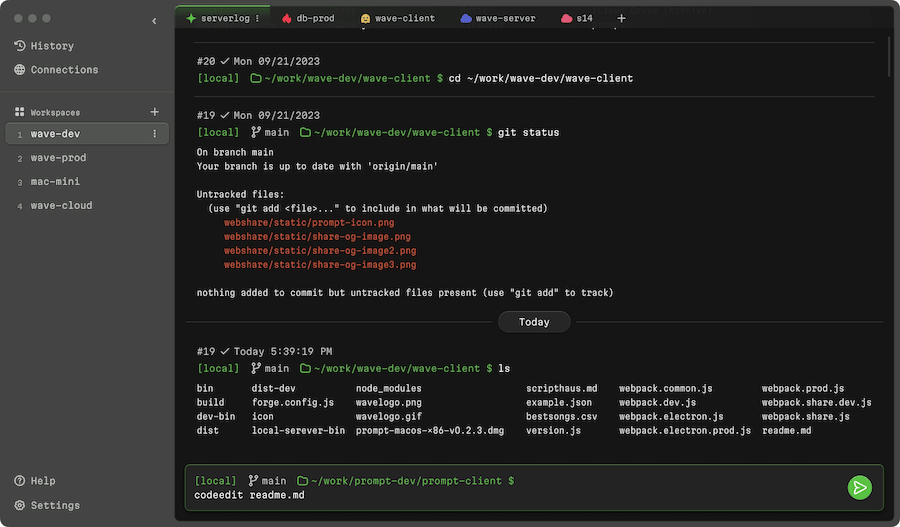How To Install Wave Terminal on Ubuntu 22.04 LTS

In this tutorial, we will show you how to install Wave Terminal on Ubuntu 22.04 LTS. In the realm of software development, the terminal is an indispensable tool. It’s the heart of a developer’s workflow, providing a powerful interface for executing commands, managing files, and interacting with the system. Among the myriad of terminal options available, Wave Terminal stands out with its modern, user-friendly design. It’s a terminal designed to make working with command-line interfaces more intuitive and less intimidating, especially for beginners.
This article assumes you have at least basic knowledge of Linux, know how to use the shell, and most importantly, you host your site on your own VPS. The installation is quite simple and assumes you are running in the root account, if not you may need to add ‘sudo‘ to the commands to get root privileges. I will show you the step-by-step installation of the Wave Terminal on Ubuntu 22.04. You can follow the same instructions for Ubuntu 22.04 and any other Debian-based distribution like Linux Mint, Elementary OS, Pop!_OS, and more as well.
Prerequisites
- A server running one of the following operating systems: Ubuntu 22.04, 20.04, and any other Debian-based distribution like Linux Mint.
- It’s recommended that you use a fresh OS install to prevent any potential issues.
- Access the terminal on your Ubuntu system, where we’ll execute the commands for a seamless WinSCP installation.
- An active internet connection. You’ll need an internet connection to download the necessary packages and dependencies for Wave Terminal.
- A
non-root sudo useror access to theroot user. We recommend acting as anon-root sudo user, however, as you can harm your system if you’re not careful when acting as the root.
Install Wave Terminal on Ubuntu 22.04 LTS Jammy Jellyfish
Step 1. Before starting the installation process, ensure that your system packages are up-to-date. You can do this by running the following command in the terminal:
sudo apt update sudo apt upgrade
Step 2. Installing Wave Terminal on Ubuntu 22.04.
The next step is to download the Wave Terminal source package. This can be done directly from the terminal using the wget command, a free utility for non-interactive download of files from the web. Enter the following command:
wget https://dl.waveterm.dev/builds/waveterm-linux-x64-v0.5.1.zip
This command will download the Wave Terminal source package to your current directory. Once the download is complete, you’ll need to extract the package. This can be done using the unzip command:
unzip waveterm-linux-x64-v0.5.1.zip
If the unzip command is not installed on your system, you can install it using the following command:
sudo apt install unzip
With the source package downloaded and extracted, you’re now ready to install Wave Terminal. Navigate to the extracted directory using the cd command:
cd waveterm-linux-x64-v0.5.1
In this directory, you’ll find the installation script. Run this script with the ./ prefix:
./install.sh
This command will execute the installation script, installing Wave Terminal on your system. If you encounter any permission issues, try running the script with sudo:
sudo ./install.sh
Step 3. Configuring Wave Terminal.
After the installation, it’s time to configure Wave Terminal for first use. This could involve setting the default shell, configuring the terminal’s appearance, or setting up keyboard shortcuts. Wave Terminal offers a variety of configuration options, allowing you to customize the terminal to suit your preferences.
To access the configuration options, open Wave Terminal and navigate to the settings menu. Here, you can change the default shell, adjust the font size and color scheme, and set up custom keyboard shortcuts. Remember to save your changes before closing the settings menu.
Step 4. Using Wave Terminal on Ubuntu.
With Wave Terminal installed and configured, you’re ready to start using it. To open Wave Terminal, simply enter waveterm in your current terminal. From there, you can execute commands, use the built-in editor, and take advantage of Wave Terminal’s user-friendly features.

Congratulations! You have successfully installed Wave Terminal. Thanks for using this tutorial for installing the Wave Terminal on the Ubuntu system. For additional help or useful information, we recommend you check the official Wave Terminal website.